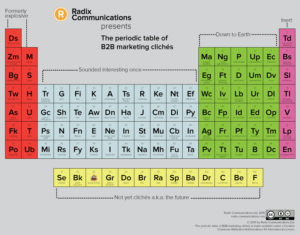
Oh no, I hear you groan.
Not *another* tired list of “business buzzwords that should be BANNED”. Can’t you think of anything more original than that?
But wait, people!
I know that, at first glance, this looks like one of those “bullshit bingo” cards transposed on to the Periodic Table of the Elements.
And if you look more closely, especially towards the right-hand side, you can probably spot a number of the usual suspects, like “blue-sky thinking”, “end-to-end”, and everyone’s perennial favourite, “solutions”.
But look again, and you’ll see that some of your other love-to-hate buzzwords are absent. There’s no “leverage”, no “synergy”, no “reach out”, and no “bandwidth”.
That’s because this isn’t yet another list of annoying corporate buzzwords. This is VERY different.
Well, OK, a *bit* different.
This is a Periodic Table of B2B Marketing Clichés.
It’s a premium collection of all those over-used words and phrases that B2B marketers use when they write stuff about their business, their products and their people.
And it’s not just the old-school clichés, like “end-to-end”, “leading provider”, “passionate” and “world-class”. Oh no. B2B marketers have a whole new set of clichés to play with now.
Everything is awesome
Anyone who’s worked in the B2B tech sector for a while will know that the vocab we use in marketing copy has undergone a huge shift in the past few years.
Almost to a man (not to mention a woman), we’ve ditched dry, polysyllabic, Latin words for perky, Valleyspeak-style language.
If I were being (slightly) academic about it, I could trace this to three things:
1) As buyers now spend 67% of the buying process looking at digital content, that content now has to do the work of a salesperson, which means it has to talk like a human being.
2) A huge proportion of business software still hails from America, where “talking like a human being” is perhaps more likely to involve terms like “awesome”, “super-fun” and “uber-amazing”.
3) A growing proportion of B2B tech buyers are not IT people, but business people. And it’s well known that all business people spend all of their time getting uber-excited about awesome productivity hacks, but have zero tolerance for tedious chat about open APIs, back-office integration and tiered storage.
The upshot of all this is that where once we wrote about “delivering enterprise-grade end-to-end solutions”, now we write about “making kickass apps that just work”.
Which, for a goodly while, was super-fun. Instead of writing like corporate copy-bots, we got to write like Cher from Clueless. It was totes amaze, B2B was sexy for the first time in, like, ever, and we all got to go to Cannes and hang out with Idris Elba, like, all the time.
But then, inevitably, everyone started writing like Cher from Clueless, and now every B2B blog post, ebook and promo email is all like “check out this super-amazing ROI calculator” or “Fifty epic ways to make over your data centre – before lunch!”
So now the new stuff is pretty clichéd too.
As, to be honest, is this whole Periodic Table of the Elements trope.
We’ve had the Periodic Table of Storytelling (actually v. good, it has “story molecules” and everything), the Periodic Table of Swearing (not for the faint-hearted), and even the Periodic Table of DevOps Tools (for hardcore periodic table fans who also love a nice bit of continuous integration).
So where better to house a collection of new-school (and old-school) B2B marketing clichés than inside a clichéd new-school content container?
(Yes, that’s a container that contains content, what of it?)
Feast your eyes on it, and while you’re doing so, revel in its time-saving possibilities.
Why waste time thinking up perky B2B blog post titles, when the Periodic Table of B2B Marketing Clichés practically writes them for you?
Fifteen Epic Near-Real-Time Insights to Transform Your Productivity, for example.
Why spend hours thinking up a strapline for your timesheet-app startup, when you can just pick off a few choice words and phrases from the “explosive” side of the table?
For example, Kieran and I spent literally seconds developing this zingy new strapline for Radix:
Radix: Story at the Speed of Fucking Powerful
Like it.
But if old ways of writing and new ways of writing are now equally clichéd, how can anyone hope to “stand out” and “cut through the noise”, I hear you ask.
Good question.
When compiling the table we did manage to identify a few words that we don’t think have yet – yet! – become clichés.
We’ve helpfully arranged these not-yet-clichés along the bottom row, from where you may pluck them for use in your next blog or email.
If we open our inboxes tomorrow to find a hundred promo emails inviting us to check out your fierce dramaturgy or become a bare-knuckle productivity seraph, we’ll know the game’s up.
Have we missed your favourite cliché? Let us know in the comments.
UPDATE: For more cliché joy, I recommend the following:
Pro Copywriters Network: The Copywriting Hype Cycle – Lungfish’s David McGuire on how a perfectly good word becomes a B2B cliché.
Stein IAS: 101 Clichés – Images can be just as clichéd as words, and Stein IAS feels so strongly about it, they’ve created an entire site dedicated to stamping out lazy B2B artwork. Raw props to you, Stein IAS.
Thanks to everyone who contributed to the table, including Matt, Kieran, Steve, John, George, Emily, and our badass copywriter bros Rod Hirsch and David McGuire. And extra kudos to our fierce Illustrator sensei Emily for conceptualising the table and making it an actual real thing.

The Periodic Table of B2B marketng clichés by Radix Communications Ltd is licensed under a Creative Commons Attribution-NoDerivatives 4.0 International License.

